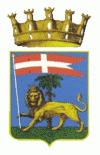Viterbo (Provincia di Viterbo)
 |
It conquered and absorbed the neighboring town of Ferento (see Ferentium) in its early history. It is approximately 80 km north of GRA (Rome) on the Via Cassia, and it is surrounded by the Monti Cimini and Monti Volsini. The historic center of the city is surrounded by medieval walls, still intact, built during the 11th and 12th centuries. Entrance to the walled center of the city is through ancient gates.
Apart from agriculture, the main resources of Viterbo's area are pottery, marble, and wood. The town is home to the Italian gold reserves, an important Academy of Fine Arts, the University of Tuscia, and the Italian Army's Aviation Command headquarters and training centre. It is located in a wide thermal area, attracting many tourists from the whole of central Italy.
The first report of the new city dates to the eighth century AD, when it is identified as Castrum Viterbii. It was fortified in 773 by the Lombard King Desiderius in his vain attempt to conquer Rome. When the popes switched to the Frankish support, Viterbo became part of the Papal States, but this status was to be highly contested by the emperors in the following centuries, until in 1095 when it was known as a free comune.
In a period in which the popes had difficulties asserting their authority over Rome, Viterbo became their favourite residence, beginning with Pope Eugene III (1145–1146) who was besieged in vain in the city walls. In 1164, Frederick Barbarossa made Viterbo the seat of his antipope Paschal III. Three years later he gave it the title of "city" and used its militias against Rome. In 1172, Viterbo started its expansion, destroying the old city of Ferento and conquering other lands. In this age it was a rich and prosperous comune, one of the most important of Central Italy, with a population of almost 60,000.
In 1207, Pope Innocent III held a council in the cathedral, but the city was later excommunicated as the favourite seat of the heretical Patarines and even defeated by the Romans. In 1210, however, Viterbo managed to defeat Emperor Otto IV and was again at war against Rome.
In the thirteenth century it was ruled alternately by the tyrants of the Gatti and Di Vico families. Frederick II drew Viterbo to the Ghibelline side in 1240, but when the citizens expelled his turbulent German troops in 1243 he returned and besieged the city, but in vain. From that point Viterbo was always a loyal Guelph city. Between 1257 and 1261 it was the seat of Pope Alexander IV, who also died there. His successor Urban IV was elected in Viterbo.
In 1266–1268, Clement IV chose Viterbo as the base of his ruthless fight against the Hohenstaufen. Here, from the loggia of the papal palace, he excommunicated the army of Conradin of Swabia which was passing on the Via Cassia, with the prophetical motto of the "lamb who is going to the sacrifice". Other popes elected in Viterbo were Gregory X (1271) and John XXI (1276) (who died in the papal palace when the ceiling of the recently built library collapsed on him while he slept), Nicholas III and the French Martin IV. The Viterbese, who did not agree with the election of a foreigner directed by the King of Naples, Charles I of Anjou, invaded the cathedral where the conclave was held, arresting two of the cardinals. They were subsequently excommunicated, and the popes avoided Viterbo for 86 years.
Without the popes, the city fell into the hands of the Di Vicos. In the fourteenth century, Giovanni di Vico had created a seignory extending to Civitavecchia, Tarquinia, Bolsena, Orvieto, Todi, Narni and Amelia. His dominion was crushed by Cardinal Gil de Albornoz in 1354, sent by the Avignonese popes to recover the Papal States, who built the castle. In 1375, the city gave its keys to Francesco Di Vico, son of the previous tyrant, but thirteen years later the people killed him and assigned the city first to Pope Urban VI, and then to Giovanni di Sciarra di Vico, Francesco's cousin. But Pope Boniface IX's troops drove him away in 1396 and established a firm papal suzerainty over the city. The last Di Vico to hold power in Viterbo was Giacomo, who was defeated in 1431.
Thenceforth Viterbo became a city of secondary importance, following the vicissitudes of the Papal States. In the 16th century it was the birthplace of Latino Latini. It became part of Italy in 1871.
Map - Viterbo (Provincia di Viterbo)
Map
Country - Italy
 |
 |
| Flag of Italy | |
Italy was the native place of many civilizations such as the Italic peoples and the Etruscans, while due to its central geographic location in Southern Europe and the Mediterranean, the country has also historically been home to myriad peoples and cultures, who immigrated to the peninsula throughout history. The Latins, native of central Italy, formed the Roman Kingdom in the 8th century BC, which eventually became a republic with a government of the Senate and the People. The Roman Republic initially conquered and assimilated its neighbours on the Italian peninsula, eventually expanding and conquering a large part of Europe, North Africa and Western Asia. By the first century BC, the Roman Empire emerged as the dominant power in the Mediterranean Basin and became a leading cultural, political and religious centre, inaugurating the Pax Romana, a period of more than 200 years during which Italy's law, technology, economy, art, and literature developed.
Currency / Language
| ISO | Currency | Symbol | Significant figures |
|---|---|---|---|
| EUR | Euro | € | 2 |
| ISO | Language |
|---|---|
| CA | Catalan language |
| CO | Corsican language |
| FR | French language |
| DE | German language |
| IT | Italian language |
| SC | Sardinian language |
| SL | Slovene language |







































